
Hello and happy Friday and Halloween weekend, vintage lovers!!!
Today I was feeling SO inspired to use my day off from A Little Wicked to continue my series on how to identify vintage based on labels and tags.
Thanks to your positive feedback on these posts and the wealth of knowledge available at my fingertips thanks to the power of the Internet, today’s post is going to cover the basics of identifying vintage based on designer name and using sources such as the Vintage Fashion Guild as well as “union” and “lot” labels on tags.
This post will get into the nitty gritty of what it takes to identify all of the above, and I’ll share what resources I used online to educate and enlighten you with this knowledge.
I’ve been having so much fun geeking out over the glory of having the power to “know” when a piece was from. It feels like opening a treasure chest and having insight into the value of the jewels and gems you’ve just uncovered!
Keep reading after the jump for part III in this series, and of course check out part I on identifying vintage (11 quick ways!) and part II for even more vintage fashion know-how.
On another very special and always important note, I hope everyone has a GLORIOUS Halloween weekend!!
I already gave a shout out to the fan page today on what everyone’s up to and dressing as for this very happy holiday! I especially love Halloween because it gives us a chance to just “be” whatever character we choose with 100 percent confidence and the contagious charisma that comes with it.
I had a ton of fun dressing as the Morton Salt girl, ’70s peace-loving flower child and sexy little leopard for my latest video on YouTube. What will you be having fun dressing as this Halloween weekend? Let me know in the comments, or on Twitter & Facebook!
Until next week, vintage lovers!
xx, SD
VINTAGE NOTE: DESIGNS “BY” INDIVIDUAL
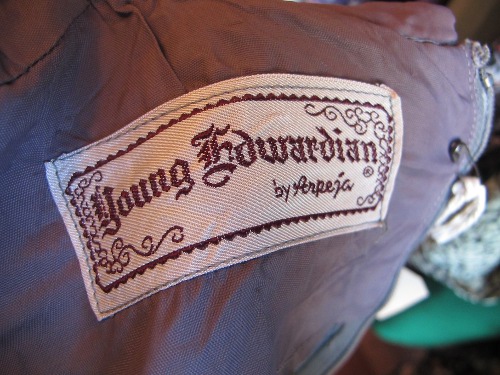
THE NOTE: When examining a vintage tag, does it give a label name followed with “by [insert name here]?”
There is typically no connection between the two “designers” on the label. Young Edwardian and Arpeja — both phonetically and visually — appear to have little connection, almost like two designers partnered to create a new line.
THE EDUCATION: Essentially what we see with this tag is a brand extension of Arpeja, which was a trendy fashion company of the ’60s and ’70s which released different subsets of its styles under various names, including Young Edwardian.
Unlike the labeling of “brand extensions” today, brand extensions of yesterday’s fashions were always linked back to the “mother brand.” That’s why you see the “by Arpeja” instead of just Young Edwardian.
Imagine if H&M wrote, “Divided by H&M.” That is basically the same thing as “Young Edwarian by Arpeja.”
But H&M today does not credit itself back to its brand extensions — rather, they live on their own, much like Old Navy and Banana Republic live on their own from the Gap, although technically The Gap owns both brands and the labels could technically say, “Old Navy by the Gap” or “Banana Republic by the Gap.”
THE VINTAGE KNOW-HOW: My theory for the reasoning behind brand extensions oh-so-often linking back to the mother brand is simply for further promotional efforts.
Imagine a world with less advertisements, no technology and yes, NO blogs, Twitter, Facebook and the like! This means that getting a new name “out there” was like pushing a rock up a hill instead of simply letting it roll down said hill without force.
So, to give the consumer insight into an already trusted, already trendy brand — when a company like Arpeja would release a new line, they realized it was in their best promotional and profitable interest to state they made the brand. It gave the consumer more incentive to buy it.
THE PIECE’S ERA: Thanks to information available at the wonderful resource that is the tag & label resource of the Vintage Fashion Guide, I was able to identify this piece from the ’70s.

VINTAGE NOTE: “LOT”
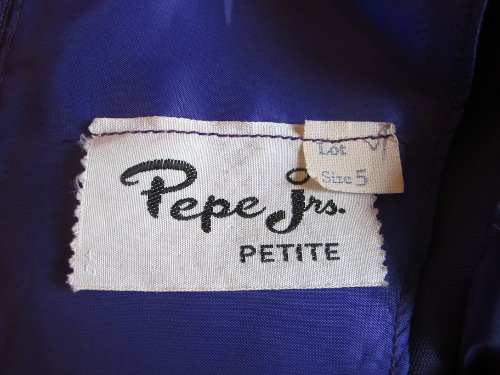
THE NOTE: The word “lot” is used somewhere on the tag, as seen on the tag above which literally rests OVER the tag stating the fashion line.
THE EDUCATION: To my most accurate knowledge — and here’s where I admit that I am always learning and my education always expanding — tags which state a “lot” illustrate that the piece was part of a “lot” of clothing produced at the same time on an assembly line in a factory.
Imagine that you are going to bake a batch of cookies. But you are going to bake THREE batches of cookies. The first batch would be “lot 1,” the second “lot 2,” and the third “lot 3.”
So when it comes to the lots of fashion, factories kept track of their “lot orders” by specifying which lot number a piece was from. That way they could track the garment and keep it in its rightful lot to be send to whomever purchased it for production.
I believe that lots were typically created by size — which is why this lot is size 5, and another would be size 7, size 9 and so on and so forth.
THE VINTAGE KNOW-HOW: Again, imagine an era without computers to keep track of things digitally. You could not just plug in a number of a garment and have the machine regurgitate the information you needed for its next best steps in the production line.
In times past, the “written” word was TRULY written!
THE PIECE’S ERA: This piece was / is / remains to be difficult to identify and to truly know “when” this fashion line “Pepe Jrs” was founded. To give you insight into how I performed some research on identifying this era, allow me to share with you my train of thought!
In musing on the brand name “Pepe,” I remembered that there is a present day company called Pepe Jeans. Upon further research, I learned that Pepe Jeans was founded as a stall in London’s Portobello Road Market of made-to-order denim in 1973.
I quickly assumed that this dress was actually by the company Pepe in a brand extension of sorts away from their denim line. But nowhere could I find — especially not in this video on the company history — evidence that Pepe Jeans also made junior girls’ dresses, despite the style of the dress most definitely resembling the ’70s and also the script of the Pepe Jrs being so similar to that of Pepe Jeans. See below!
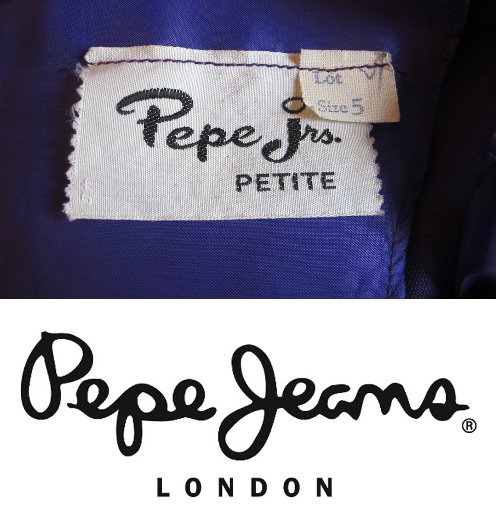
So, because I struck out on true conclusive evidence as to whether or not this brand label was truly that of Pepe Jeans London, I decided to do some research on the idea of “petite” sizing. In other words, my brain began to think: “When was petite sizing invented?”
Well, it turns out that it was invented in the ’40s-’50s based on statistical data of a women’s proportions, i.e. if her body length is this long than her waist is this size. Almost a “this therefore that” assumption.
I found that the “petite” sizes were produced for the junior — presumably, teen — audience using the sizes 3, 5, 7, 9 and so on.
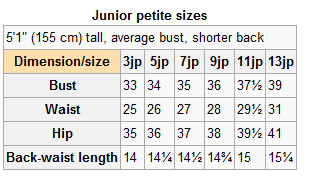
Now while this knowledge is still quite fascinating, it’s not too helpful in confirming a piece’s era based on tag alone. So, the next step is quite honestly to examine the production and style of the piece and using all of the information previously gathered, giving my best educated guess.
While the dress looks like a mini dress — a style popular in the ’60s — it was actually hemmed, and so most likely was a maxi dress style of the ’70s. Further evidence is the quality of craftsmanship here — the stitches are straight and the zipper is plastic, a sign that this was most likely made after the ’60s.
The most valuable piece of information is truly the “lot,” which is a piece of language I personally haven’t seen on clothing prior to the ’70s. It’s a hard judgement call on this piece, though, because I could be SO off and it was produced closer to the ’80s than the early ’70s, which is a piece of information that can truly separate pieces in terms of style and quality.
Like hairstyles from early 2000s, clothing styles differ significantly — at least by trend — between then and today in 2011. The same can be said from pieces dating between entire decades: It’s not always most accurate to identify a piece strictly by its decade.
But vintage lovers, for the sake of making SOME conclusion here I am sure this dates from the ’70s. But if someone disagrees and has reason why, please I implore you: Leave me a comment with your evidence & explanation!

VINTAGE NOTE: UNION TAGS
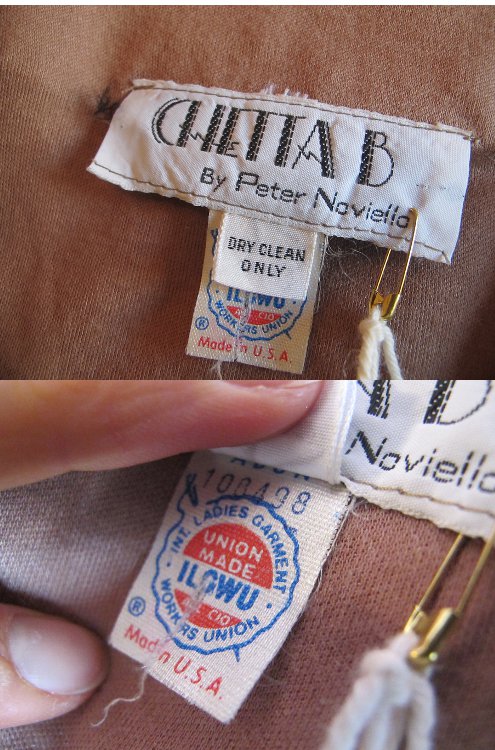
THE NOTE: If the piece has a union tag included below the fashion company label, you can use this handy Union Label Guide from Ebay to very accurately identify the era of the piece based on the union tag’s design.
THE EDUCATION: ILGWU stands for International Ladies Garment Workers Union, and was first established in NYC in 1900.
The tags included in garments produced by the ILGWU changed over periods of time, which helps vintage sellers and lovers alike to identify just when a piece was produced by the union.
THE VINTAGE KNOW-HOW: The union label above is of the red, white and blue design which was instated in 1974 to ” to support the fight against the competition from low-wage imports, particularly to strengthen the nation-wide anti-imports campaign,” according to the guide on Ebay.
Makes a lot of sense: Beginning in the ’70s, materials and garment production were being outsourced and the “All-American made” mantra was becoming watered down.
THE PIECE’S ERA: Vintage lovers, here is where I truly just geeked out on researching the true era of this Chetta B piece.
Based on my knowledge previous to this research, I would have told you that this piece was from the ’80s. The typography, the dress style and the company name — at least at first glance — screamed ’80s to me.
BOY WAS I WRONG! Allow me to explain what I did to learn that this piece was produced as early as …. 1995!!!!!!
Note the number that is stenciled on top of the Union Tag: it is 108498. That number is the “RN number” to a piece produced in the United States as issued by the Federal Trade Commission “to a business residing in the Unit States engaged in manufacture, importing, distribution or sale of textile, wool, or fur products” according to the guide to RN numbers I found on Ebay.
So how did I come to the very accurate conclusion that this Chetta B dress was first produced in 1995?
As the guide explains, I took the RN number and followed this formula:
Your RN #
-13670 (first RN # in series)
Total #s between the original and yours/2635(average #s issued per year) = # of years since issue date
1959 + # of years since issue date = estimated year of issue
So here’s what happened for me:
108498
– 13670
= 94828 / 2635 = 35.98
(rounded up to 36): 1959 + 36 = 1995!
This formula was worked out by the author of the RN # guide on Ebay and the Vintage Clothing & Accessories Board. According to their reasoning for this formula, “It was determined that an average of 2635 numbers have been issued per year. The earliest number in the series beginning in 1959 is 13670.”
Vintage lovers, my mind is literally BLOWN. If it weren’t for this small tweak in how we calculate the year of production for union pieces, we can know almost to the year when a piece was produced.
I double checked the founding of Chetta B — just to be sure there wasn’t some mistake in my adding/substracting/dividing.
What did I find? Chetta B was founded IN 1995! So there’s no way this piece could be any older than 1995 anyway.
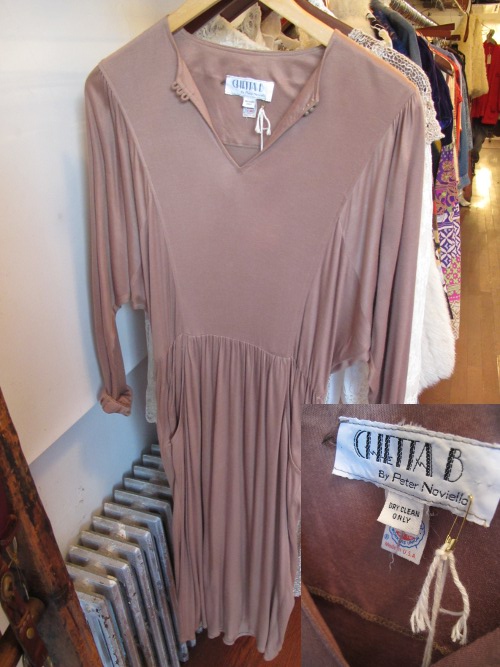

Such a great article!
Especially for us vintage lovers! love it
Thanks Sammy! <3 <3
I’m really loving this series of posts you have going on! Very helpful! :)
One thing that I think is important to note when using the RN number to date an item is that it only tells you the earliest the item could have been made – but companies may use the RN number for various similar styles for decades. We have particularly found that a lot of scarves have an RN number that dates to the 60’s, but was actually produced in the 70’s, 80’s or later. Shoppers should definitely not get super excited about an item with an old RN number right away – it has to be checked against your other dating tips as well! :)
Wow! This is such a thorough post. I know to look for labels and can easily spot a vintage label with the naked eye, but the additional info you’ve added here interesting and informative! Thank you!
thank you so much for gathering up and sharing your vintage knowledge. I stumbled upon your site in search of determining vintage age by label. (I have a “made in Korea” and knew I had read some where before that the US only imported from Korea during certain years… would still like to find that link but your info has been helpful.
Awesome! I got a camel-colored suede blazer/jacket for $10 at a thrift store with an Express Internationale Campaigne tag – based on the RN # math, it was probably made in 1985! Thanks for the tips, I will use them more often in my hunt for vintage items!
Hey Joy! Late reply here: SO GLAD you were able to use that RN math and figure it out! I love that. *geek out* xoxo
Hi Sammy,
First I want to thank you for your articles. I have learned quite a lot from reading them. I just finished reading an article of yours on dating by the label. One of the labels you used as an example was “Chetta B” which by your research was founded in 1995. Now…the only reason I ran another searched after reading your article is because I have a fromal dress that I picked up the other day that is identical to a dress that an old friend had purchase between 1982-1984 that I absolutely loved, but because I could not remember the label of that dress…I could not be completely sure that the dress I found was from that time. After doing a bit of research on “Cheeta B” I found a site (included) that states that the company was founded in the 80′s which would match up to the time frame of the dress that my friend purchase back in the early 80’s.
Company info website: http://www.manta.com/c/mmfc151/b-chetta-inc
Thank you again for your informative articles!
Tammie
Hi! According to RN calculating method that you described, a dress that I have recently bought was made in 1975. However, there is no lot number, only style, size and RN. It says dry clean, made in USA.
It’s all new new and there is attached a large tag.
Is this RN method really reliable?
you should be give all informations about all brands tags
I found the RN Number for Chetta B. it is 60299 this is the site, I use to identify vintage labels I don’t know, very useful.https://rn.ftc.gov/pls/textilern/wrnquery$tts_rn.queryview?P_RN_TYPE=RN&P_RN_SEQ=60299&Z_CHK=44775
You can use this site if all you have is an RN number, and you don’t recognize the name. If you just have the name and you want the RN, this site can help https://rn.ftc.gov/pls/textilern/wrnquery$.startup
Greetings,
As for the RN dating guide, I am not sure it works for Ralph Lauren clothes.
I have a Ralph Lauren shirt here (four actually) with RN# 41381
According to your RN equation this would mean that the shirts were made in 1970, which I am almost positive that they were not.
Is there a different formula for 5 digit RNs?
It seems that RNs are only given out once for the manufacturer, which means that they shouldn’t be used to determine age.
I love your site, I have been wandering around it for almost two hours now. :) But I still haven’t found the answer to my initial question of how to determine the date of my Ralph Lauren merchandise.
Can you please help me?
I believe the horse label is from the 80s and the Box label started in the 90s.
But there is also a number underneath the tag that my beother has told me is the actual year of manufacture, for example…
s(02) he said was from 2002.
s(04) was from 2004.
But then I came across something like 863… and I began to question that theory. :)
Can you please help me find an answer? I cannot find it on the internet anywhere that I have looked.
Many thanks, love the site!
Dax
I believe that Chetta B was founded in the early 1980’s. Here’s the link to an article I remembered from awhile back: https://www.google.com/amp/s/www.deseret.com/platform/amp/1988/7/7/18771112/chetta-b-br-one-of-the-hottest-design-teams-on-the-fashion-scene